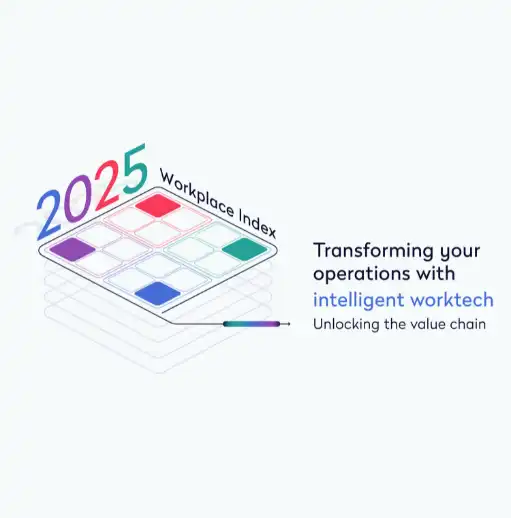
This January was a big month in the world of artificial intelligence (AI). In the U.S., the federal government announced a $500 million joint venture to build more data centers and strengthen America’s AI infrastructure. Meanwhile, DeepSeek, a Chinese AI company, released a new app that shook stock markets with its claims of processing speed and accuracy at a fraction of the cost of their industry peers. The exact implications for the future of AI are unclear, but both these developments suggest that the technology will become even more powerful, affordable, and widespread. For facility, workplace, and maintenance professionals, understanding AI has never been more important.
Welcome to our new monthly series where we go beyond the headlines to keep you up to date on facility management (FM) industry trends.
A quick introduction to AI’s role in the future of facility and asset management
AI will change how facility and maintenance managers operate, delivering a range of applications that enhance efficiency, reduce costs, and improve overall service quality. For example, departments can leverage the technology to automatically generate work orders based on real-time data, such as equipment performance and usage patterns. AI-backed workflows not only speed up response times but also ensure that maintenance tasks are scheduled more accurately, reducing downtime, and extending equipment life spans.
An organization can also use AI to analyze energy consumption patterns to identify inefficiencies and suggest optimizations. For example, an AI can monitor HVAC systems, lighting, and other energy-intensive equipment to ensure they are operating at optimal levels. Maintenance departments can use AI to predict and prevent equipment failures by continuously monitoring performance data and alerting maintenance teams to potential issues before they become critical. A proactive approach to maintenance helps facility managers avoid unexpected breakdowns and the associated costs and disruptions.
All these potential benefits are what makes the push to successfully implement AI so important. But the first step for facility and maintenance professionals is understanding how AI works, where best to add it to existing workflows, and why projects that include AI still need to focus on people.
Leveraging AI starts with understanding what it can and can’t do
In the wide-ranging webinar “AI’s role in solving key business challenges,” Dean Stanberry, past chair of the International Facility Management Association (IFMA) Global Board of Directors, explains why it isn’t just AI tech that’s creating a new era in FM. It’s the accessibility. AI’s been around since the 1950s, but it wasn’t until recently that it made its way into the mainstream. He points to 2022, when everyone was suddenly talking about ChatGPT as a watershed moment.
“It is a game changer… we’re just going to continue to see it evolve and grow,” he says.
But what does the new game look like?
Stanberry discusses how AI augments human capabilities in the FM industry to drive operational excellence. For example, teams can leverage AI for predictive maintenance and energy management to space utilization and fault detection.
“AI is helping you be more productive in a lot of ways… It’s looking at all that data and telling you when you need to go look at it, rather than having someone just go out and look at it just for the sake of looking,” Stanberry says.
And there are applications beyond the facility and maintenance teams. He talks about how AI systems can enhance the user experience by automating various processes and tasks in a commercial building, from parking to coffee preparation.
But here he is careful to highlight the difference between automating tasks and replacing the need for human skills. He says organizations will always need FM professionals. The AI is there to help free up their time and focus so they can work on tasks that require human skills and emotional intelligence.
FMs should “lean in” to AI and other new technologies
Stanberry wants FM and maintenance leaders to embrace AI, encouraging them to, “Lean into it, learn about it, and make it a part of your skill set.”
What are some practical steps FMs can take to “lean in”?
In the Workplace Innovator podcast episode 335, “’Be Aware’ – Disruptive Workplaces and Creating Future-Proof Work Environments,” Tom Ryckaert, co-founder and managing partner at 2nRich says FMs need to keep up with developments in technology, particularly AI. But that’s not the same as becoming an expert in the field. Instead, they should be building connections with area experts who can provide further insight and knowledge in these areas.
“Make sure that you are aware of what’s happening. And the second thing is that you have a network with experts who can help you with bringing you further in those domains.”
In episode 334, “’Understand the Challenges’ – Facility Management and CRE Tech Leadership in 2025”, guest Ed Buckley, Vice President of Facilities Operations at TDIndustries, explains the value of learning about AI and how easy it can be to get started.
“Given that it’s going to be all pervasive, I think it’s incumbent upon us to figure out how we can use technology to enable our frontline teams to focus on the work that they like doing and that only they can do, frankly.”
Those first steps can be small. He suggests everyone should “download ChatGPT or Claude onto your phone and just have a go. AI is a great technology in that you don’t need to understand how it works in the background to get benefit from it.”
Successfully implementing new technologies depends on change management
Along with advice on how to think about and get started with AI, there were also some great insights into how to ensure everyone in an organization is embracing new technologies.
Success means FMs must master the art and science of managing organizational culture and behavior.
Part of that, according to Ryckaert, is having a good working concept of change management. In the podcast, he compares change management to an iceberg, with visible changes being only the tip and deeper, less noticeable shifts lying beneath the surface.
“I always like to compare it with the iceberg principle. So, you know, above the surface you see the peak and that’s clear and that’s what we’re good at… But then you see below the surface, you have all the other things about the resistance, about politics, about culture, and those kinds of things.”
Buckley talks about matching technology to challenges. People will embrace solutions that work for them, make their work lives easier.
His advice for finding out what people need?
“Do a ride along with a technician or a frontline teammate and really watch and try to understand the challenges that they’re faced with as they go about their daily lives.” From there, you can figure out if there’s one change that you can make that improves the lives of those frontline technicians and teams, which will then have a big impact on your customers in the workplace.”
Over at the Asset Champion podcast, we found even more advice on getting people on board with new initiatives. In episode 145, “’Serving a Purpose’ – Facilities Maintenance, Restoration, and Training,” Lisa Lavender, CEO at Lever360, speaks about the critical role leadership plays.
She explains: “Impact is related 70% to management engagement,” explains Lavender. “When we don’t have the leadership throughout the company buying in and engaged with people who are training, that’s going to be a barrier to getting that impact from training.”
Stay on top of the trends in intelligent worktech and facility management
Staying informed on the latest industry developments is essential for professional success. Workplace and facility management are constantly evolving with new technologies, regulations, and best practices. When the margin for error is slim, being well-informed is a key differentiator that can set successful facility professionals apart.
For more videos, podcasts, and webinars to keep you updated on the latest trends, visit our resource page.








